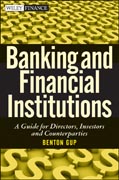
Banking and financial institutions: a guide for directors, investors, and borrowers
Gup, Benton E.
A practical guide to the evolving world of banking and financial institutionsDue to various factors, ranging from the global financial crisis that began in 2007 to new laws such as the Dodd-Frank Wall Street Reform and Consumer Protection Act of 2010, banks and financial institutions have had to alter the waythey operate. Understanding how these institutions function in the face of recent challenges is essential for anyone associated with them. That's why Professor Benton Gup has created Banking and Financial Institutions. Opening with adetailed discussion of the causes of the recent financial crisis, as well as a look at some lessons we can learn from it and other crises, this reliable resource quickly moves on to put modern banking in perspective. Filled with in-depth insights and expert advice, Banking and Financial Institutions examines the essential aspects of this discipline and shows you what it takes to make the most informed decisions possible, whether you're a bank director, investor, or borrower. Explains the economic role of financial intermediaries, includingthe financial institutions that bring borrowers and savers together Addresseshow banks can hedge some of their interest rate and credit risks by using various types of derivatives contracts, options, and futures Analyzes the processof commercial and industrial (C&I) lending, from how banks make loans and thetypes of C&I loans to the role of collateral Allows you to evaluate a bank's financial statements and performance Explores payments systems, including cash, checks, credit cards, wire transfers, and other means of payment Rounding out this detailed banking guide is an informative chapter on Islamic banking written by Professor Mohamed Ariff of Bond University, as well as a chapter filled with tips for bank directors, borrowers, and investors contributed by John Harrison, the Superintendent of Banks, Alabama State Banking Department. INDICE: Preface. Acknowledgements. About the Author. Chapter 1 Lessons Learned From Banking Crises. International Financial Crises. What Caused the Crisis in the United States? Lessons Learned From Financial Crises. Chapter 2 The Economic Role of Financial Intermediaries. The Economic and Financial System. Intermediation. Asset Management. Individuals. Interest Rates. Current Trends in Financial Intermediaries. The Changing Role of Banks. Alternative FinancialServices. Chapter 3 The Evolving Legal Environment. What is a Bank? Why Are Banks Regulated? Selected Banking Laws. Services Provided by Banks. What Bank Regulators Do. Is Prudential Bank Regulation Effective? Appendix 3A: FDIC Definitions of Commercial Banks. Appendix 3B: Selected Banking Legislation. Chapter4 Asset/Liability Management (ALM). An Overview of Market Rates of Interest. The Effects of Interest Rate Risk on Income and Market Value. Managing Interest Rate Spreads. Duration Gap and Economic Value of Equity. Duration Gap Management Strategies. Chapter 5 Hedging and Risk Management. Derivatives. Risks Associated With Derivatives. Derivative Contracts by Product and Type. Hedging With Interest Rate Swaps. Hedging With Currency Swaps. Hedging With Options. Hedging With Futures. Covered Bonds. Special Purpose Vehicles (SPVs). Enterprise Risk Management (ERM). Additional Educational Resources. Chapter 6 Commercial and Industrial Loans. The Role of Asymmetric Information in Lending. The Competitive Environment. The Board of Directors Written Loan Policy. Seven Ways to Make Loans. Collecting Loans. Principal Lending Activities. Collateral. The Lending Process. International Lending. Summary. Chapter 7 Real Estate and Consumer Lending. Real Estate Lending. Characteristics of Mortgage Loans. Consumer Lending. Finance Charges. Annual Percentage Rate. Real Estate and Consumer Credit Regulation. If Credit is Denied. Privacy Issues. Credit Card Accountability, Responsibility and Disclosure Act of 2009 (Credit CARD Act). Conclusion. Chapter 8 Bank Capital Capital Adequacy. Basel Capital Accords. Enterprise Risk Management (ERM) and Economic Capital. Accounting Issues. Whats Next? Chapter 9 Evaluating Bank Performance. Evaluating Publicly Traded Banks. Evaluating Commercial Banks. Appendix 9A: FDIC Bank Data Guide. Chapter 10 Payments Systems. Money. Legal Tender. Retail Payments. Large-Interbank Payments. Chapter 11 Other Financial Services. Cash Management Services. Trust Services, Private Wealth and Asset Management. Chapter 12 A Guide to Islamic Banking (By Mohamed Ariff). Islamic Banking, an Alternative Intermediation. Special Question on Intermediation by Banks. Future Direction. Chapter 13 The View from the Top: Recommendations from A Superintendent of Banks (By John D. Harrison). Tips for BankDirectors. Tips for Borrowers. Tips for Investors. What Lies Ahead. Notes. Glossary. References. Index.
- ISBN: 978-0-470-87947-4
- Editorial: John Wiley & Sons
- Encuadernacion: Cartoné
- Páginas: 384
- Fecha Publicación: 20/07/2011
- Nº Volúmenes: 1
- Idioma: Inglés
